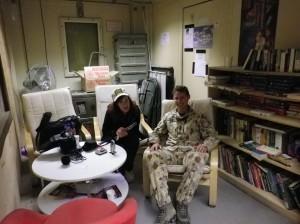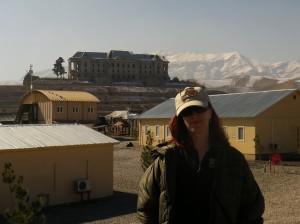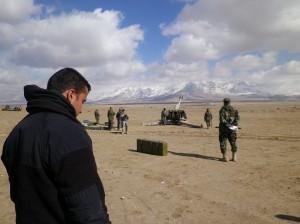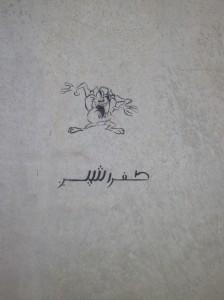Curating from Afghanistan : Collecting in Action, February 2011
As senior curator of Film and Sound at the Memorial, I was greatly privileged in February this year to go with the ADF to the Australia’s area of Middle Eastern Operations. Not only did I meet with and interview an amazing range of ADF members based in or around Al Minhad, Kandahar, Tarin Kot and Kabul, but I found myself in the rare position of being a female civilian, totally immersed in the ADF’s world. I trained with ADF. I wore body armour. I travelled by armoured convoy and by Hercules aircraft.

Interviewing at Camp Holland, Tarin Kot.
I had meals in the food halls where everybody else ate - lining up outside to sterilise my hands - and slept in the same accommodation, sharing bathroom and laundry facilities. Every day brought a hectic round of new names, acronyms, places, and protocols to remember; every day was a day of early starts and late nights. Some days were marked by fun (joining in Camp Baker's Trivia Night) or frustration (repeated cancellation of flights), whilst other days were memorable for their sadness – the loss of an Australian sapper the day we left Tarin Kot; attending, with a host of coalition force members, a US ramp ceremony at Kandahar Airfield.
There was nothing about this trip for which the standard day at the office could have prepared me.
As one of a three person team of Memorial curators for the Collecting in Action program, I spent three weeks on deployment, travelling across the Middle Eastern Area of Operations (MEAO). In keeping with the Memorial ‘s tradition of documenting Australians’ experience at war, I recorded interviews with a wide cross section of the ADF - men and women of different ranks, performing different duties , in a range of locations on base and in the field. Their stories were fascinating and inspiring, providing a unique insight into the life and times of Australia’s current serving military. The team also sought items to include in the Memorial’s collection, from photographs and personal cloth patches, to gear too big to bring back right away, such as vehicles.
This video compiles a small selection from the many hours recorded during my deployment. The Memorial thanks all those who contributed their time to this program.
The ADF do their utmost to prepare you for travelling to a war zone. Along with a large cohort of ADF members, our team undertook a training course at Randwick Barracks. Full days of lectures covered topics as diverse as vaccination, how to speak to the media, and how to conduct oneself in the event of capture. A month later we departed with the scheduled ADF sustainment flight to Australia’s Al Minhad base, where we undertook a further four days of lecturers and training. This included being taught how to assemble and fire a rifle, how to identify explosive devices, to call in a medivac (evacuation by air), how to apply a tourniquet, and how to dress an open wound. My wound dressing skills being somewhat more theoretical than actual, I quietly hoped no one would have to depend on my training in an emergency!
During the training period I met many people who were , like me , about to go “in country”, but unlike me, would stay on for many months past the date of my return to the comforts of “civvy” life. They would continue to work the long hours, in harsh environmental conditions, which characterise Middle Eastern and Central Asian deployments. These and other ”pattern of life” matters were discussed by many of my interviewees.

Outside Kabul.
My interviewees included troopers, snipers, members of mentoring task groups, medical staff, unmanned aerial vehicle operators, artillery trainers, ground support crew, engineers, a Chaplin, a legal officer, a Federal policeman and, offering a different perspective, an Afghan translator. In every case, I asked them how they came to enlist, what brought them to their current situation, what their jobs entailed, what life is like on an Australian base. What did they enjoy about life in the Forces, what was not so good? If they had any downtime, how did they spend it? And what is it like to work with other nationalities?

Artillery practice.
People willingly shared their experiences, personal insights and thoughts for the future. A nurse spoke of the bravery of an Afghan child who’d sustained horrific facial injury in a tractor incident. A Lieutenant Colonel, remembering his earlier work the UN, described having to repatriate the bodies of UN personnel killed in the war between Hezbollah and Israel. A postal operator, missing her own young family, told how amongst the inmates of Camp Baker she was known as the Morale Princess, for distributing precious news and gifts from home. An experienced Warrant Officer described the importance of keeping people busy when sad events at home or at war tested their morale. One interviewee showed me his publically displayed artworks, which, while allowing him artistic outlet, enlivened both his spare time and the walls of the base , pleasing ADF and coalition personnel alike. A sniper described how his team narrowly avoided being taken out by an insurgent with a rocket propelled grenade launcher. A female officer told me about the respect shown her as a trainer, working with Afghan military. Another interviewee described meeting his Canadian fiancée at a fitness class on base.

Stencil Art - Kandahar Airlfield Base.
Some interviewees felt they might not have enough to tell, or suggested that they “weren’t interesting enough”. The fact is everyone has a story to tell. Not only are their individual experiences interesting in their own right, but every single interview contributes a part to the whole story of Australia’s history. In the years to come, their descendants will come to the Memorial seeking out their stories, just as the grandchildren and great grandchildren of our First and Second World War veterans are now looking for the records and recordings of their ancestors, which form the Memorial’s collections.
The Memorial seeks to build its collection of film, photo and oral history with material from current and recently serving ADF members. Please contact the Film and Sound section if you would like to help.